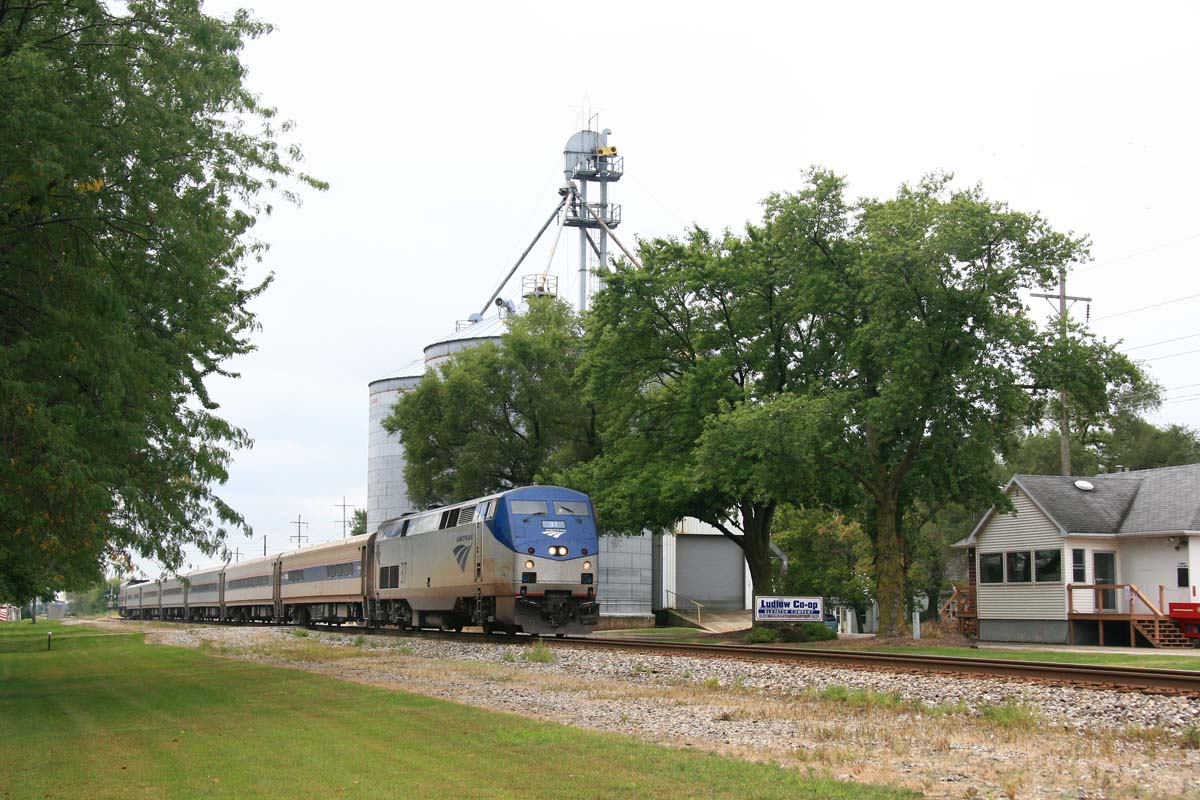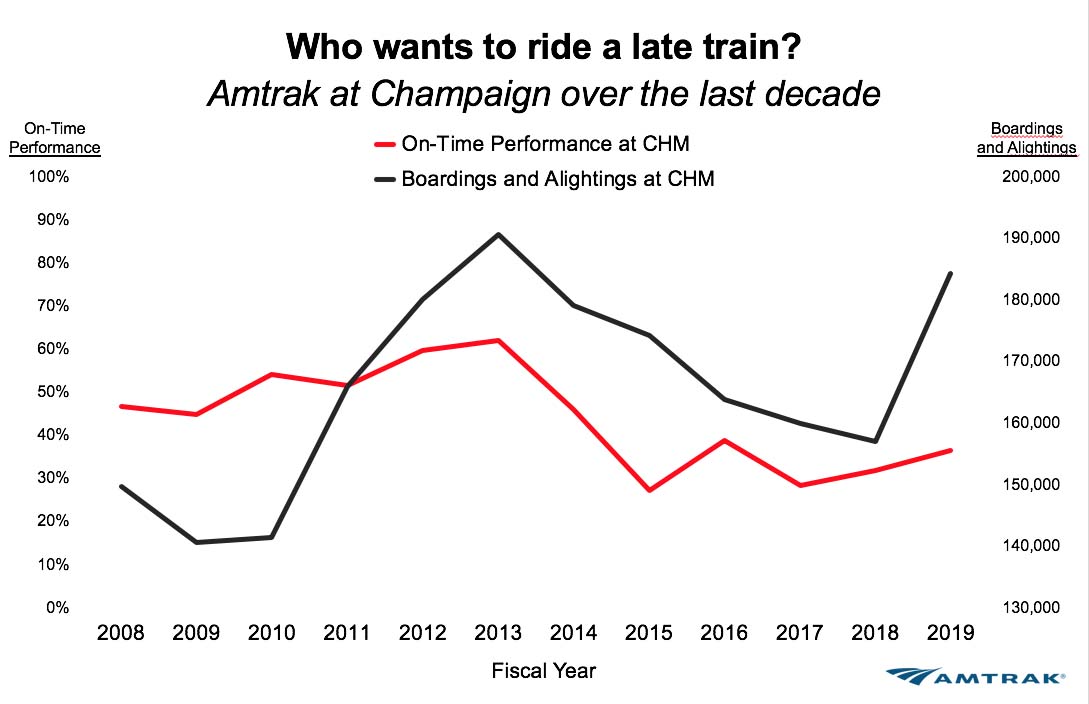Davis, a member of the House Rail Subcommittee that recently held an Amtrak oversight hearing, added, “At this point, I want to try and solve (the on-time performance) problem without going to litigation. When litigation is involved, it will prolong the final solution.”
Durbin announced a bill the previous day that would allow Amtrak to sue host railroads, “to enforce its statutory preference” over freight trains.
As defined in Section 24308(c) of Title 49, United States Code, railroads are required to give “preference to intercity and commuter passenger transportation over freight transportation in using a rail line, junction, or crossing.” Always sidelining freight trains is not practical, so the Passenger Rail Investment and Improvement Act attempted to quantify the requirement utilizing an on time performance metric.
In the case of the Chicago-Carbondale corridor, Amtrak and the state’s relationship with CN has been contentious since 2006, when Canadian National then-CEO, Hunter Harrison, attempted to block the Saluki round-trip’s addition to the schedule after it was agreed to by a lower level railroad manager. Durbin got involved, and Harrison backed down, but delays to the morning trains in each direction have been prevalent ever since.
“There is a correlation between poor on time performance and reduced patronage at Champaign, and that affects Illinois taxpayers who help support the service,” Amtrak spokesman Marc Magliari tells Trains News Wire. At the meeting, Amtrak showed a PowerPoint plotting similarities between Champaign delays and ridership ups and downs for all trains over the past decade. For fiscal 2019, the two trains were on-time at their endpoints only 26% of the time (though the table also factors in the City of New Orleans, which has more recovery time built in to its schedule).
“Because the distance from Champaign to Chicago is relatively short, we are much more vulnerable to leak ridership from there when taking the train becomes unreliable,” Magliari says.
One of the contributing factors to ongoing tardiness revealed at the meeting is CN’s insistence on a 60 mph speed limit over any highway crossing protected by electronic warning devices between University Park and Centralia for the Amfleet or Horizon coach-equipped Illini and Saluki. This limit was added in 2014 in addition to a requirement that each of these trains run with at least 32 axles to ensure a proper shunt of signals and crossing gates.
The two Canadian National representatives at the closed door session opted not to participate in the news conference following the meeting. Neither CN nor the Association of American Railroads has responded to Trains News Wire requests for a comment on Sen. Durbin’s proposal and Rep. Davis’ stated belief that giving Amtrak the right to sue a host railroad would prolong a solution to on time performance issues.
















Thanks John for correction
@Charles Landey: To correct a prior post. You can take air travel from MKE (Milwaukee Mitchell) to CMI (C-U Willard). American Eagle provides the flights with a connection iat Chicago-O’Hare.
Mr. Davis seems to be a politician with some brains. Whoda thunk! Maybe if Amtrak was forced, by law and the threat of lawsuits, to pay the Class 1s the true cost of hauling their trains then they might be more willing to give them preference. Amtrak is subsidized twice. Once by the taxpayers (federal and some state) and once by the freight railroads. Use incentive payments. But in reality if someone is riding Amtrak just about anywhere outside the NEC and other corridors they aren’t in any real rush to get where they are going.
The article doesn’t mention that the new state capital bill included $100 million to add capacity to this corridor. CN watched over the past decade as UP got their GM&O route rebuilt with government dollars, and now they want theirs. Now that they are about to get it Durbin wants to sue them. Anyone who has been involved with litigation on this scale knows that it does delay a final agreement. Keep talking, folks.
Give Amtrak the right to sue! The railroads I’ve had years and years to figure this problem out. They don’t care! They’re in it to make a profit and they are going to take care of them selves ahead of Amtrak unless Amtrak has a way to enforce the lawy
How about going back to the original Amtrak authorization law, resurrecting the original intent about railroads having to prioritize Amtrak and putting that into law, with appropriate monetary penalties imposed by the STB. It’s a simple regulation not against any existing law and not likely to be struck down in a court of law or by the SCOTUS, it’s the railroads own fault at this point and might make them and Wall Street wake up to the lack of capacity(though I highly doubt that). While we’re at it, include simpler mechanisms for adding additional service in short to medium length hauls, and something that would allow duplicate but opposite services on the long haul services(departures 12 hours apart with the schedule appropriately the same across the board: i.e. you have an 8 am and 8 pm departure from Chicago to Los Angeles).
If Mr. Durbin wants to do something socially useful he could advocate for the long-proposed direct connection between the former ICRR and the former PRR to take the Champaign – Carbondale – New Orleans trains directly into Union Station. How long has this proposal been out there? Oh, I don’t know, call it about 48 years. Progress to date: none.
Quite frankly the I-57 corridor is one of Amtrak’s flopperooos for a number of reasons including what I mention above. Admittedly I’ve never caught it during semester break at the various universities along the line, but other than that I’m rather unimpressed by the ridership count. Over the Amtrak years we’ve gone from the high-stepping ICRR double-iron passenger corridor (admittedly on lousy track) to a schleppidiche freight line almost irrelevant to Amtrak.
Imagine a Milwaukee – area resident attending U of Illinois at Shampoo – Banana. Air service doesn’t exist, only driving, the bus or Amtrak. Contrast the fast, well-patronized Hiawatha end of Amtrak (Canadian Pacific) to the I-57 half (Canadian National). Sad.
You have to be kidding. This problem is decades old. More blab isn’t going to solve the issue. Time for the brass knuckles. The railroads have cut infrastructure to further inhibit flexibility. That is their tough luck. Besides, Amtrak is a scheduled railroad just like the Class I’s with PSR. The railroads are in a recession now. Freight traffic has diminished although moving now in longer trains. There is no excuse for what the Class I’s do to Amtrak’s on time performance.
This is a good cop/bad cop approach to getting CN to comply.
Durbin is the bad cop by hanging a lawsuit over them. Davis is the good cop saying lets chat.
CN ends up complying with something in between.
A good metric to publish is a comparative of Via Rail ontime performance on CN in Canada vs Amtrak performance on CN in the US.